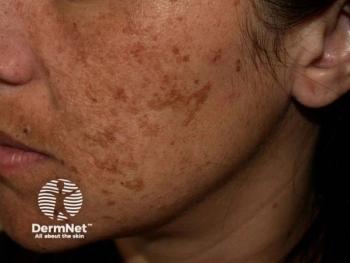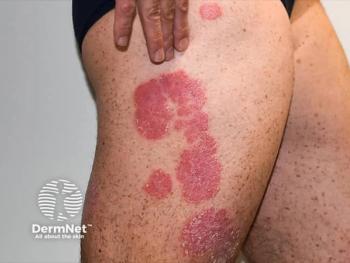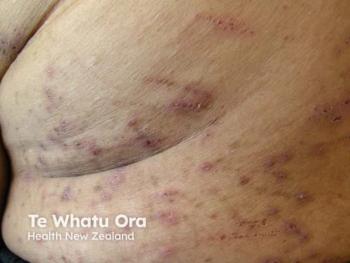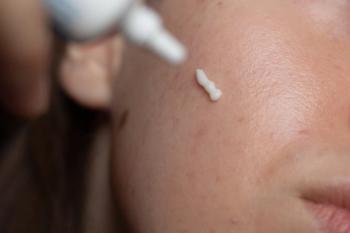
- Dermatology Times, June 2025 (Vol. 46. No. 06)
- Volume 46
- Issue 06
Understanding Chronic Hand Eczema: Cellular Mechanisms and Therapeutic Implications
Key Takeaways
- CHE involves skin barrier dysfunction, innate and adaptive immune activation, and a mixed Th1/Th2/Th17 immune profile, differentiating it from atopic dermatitis and psoriasis.
- Keratinocytes contribute to inflammation and epidermal remodeling in CHE, releasing pro-inflammatory molecules and antimicrobial peptides, and promoting neurogenic inflammation.
Omar Noor, MD, FAAD, explores the complex immune and cellular mechanisms behind CHE and highlights its significant physical and emotional toll on patients.
Chronic hand eczema (CHE) is a persistent inflammatory skin disorder characterized by dryness, erythema, scaling, fissures, pain, and intense pruritus on the hands. Hand eczema is classified as chronic when symptoms persist for over 3 months or recur multiple times within a year. CHE has a significant impact on quality of life as well as social and occupational impact, particularly in individuals with high irritant exposure, such as health care workers and manual laborers. Advances in dermatological immunology have begun to clarify the cellular mechanisms behind CHE and how it diverges from related skin diseases such as atopic dermatitis (AD) and psoriasis.
Impact on Patients
CHE’s burden extends beyond physical discomfort. Pain, itching, and visible lesions interfere with daily tasks and can reduce productivity or result in job loss, especially in professions requiring frequent handwashing. Social embarrassment and stigma often lead to anxiety, depression, and isolation. The relapsing nature of the disease and limited availability and efficacy of long-term treatments can foster emotional distress and treatment fatigue.
Skin Barrier Dysfunction in CHE
A key factor in CHE is skin barrier impairment. Normally, the skin barrier relies on lipids, corneocytes, and proteins such as filaggrin. In many patients with CHE, mutations in the filaggrin gene reduce barrier integrity, allowing allergens and irritants to penetrate more easily. This sets off immune responses that, in predisposed individuals, evolve into chronic inflammation. Unlike acute dermatitis, CHE involves a sustained loop of barrier damage and immune activation.
Innate Immune Activation
Barrier disruption activates the innate immune system. Damaged keratinocytes release IL-1α, IL-1β, IL-6, and TNF-α, which trigger local dendritic cells and macrophages. These, in turn, produce chemokines like CCL2 and CCL20, recruiting neutrophils and amplifying inflammation. This initial wave of immune activation primes the skin for chronic adaptive immune involvement.
Adaptive Immune Responses
CHE involves a broad spectrum of adaptive immune responses that vary by subtype, although there is significant overlap of both subtypes and immune mechanisms.
- Th1 Dominance: Seen predominantly in irritant and allergic variants, Th1 cells produce IFN-γ and IL-2, promoting macrophage activity and contributing to chronicity.
- Th2 Activation: More common in atopic CHE, Th2 cytokines such as IL-4, IL-5, IL-13, and IL-31 drive eosinophilic inflammation and chronic itch. IL-31 is particularly involved in pruritus.
- Th17/Th22 Activity: IL-17 and IL-22 drive keratinocyte proliferation and epidermal thickening, occasionally resembling psoriasis. IL-22 impairs keratinocyte differentiation, while IL-17 boosts antimicrobial peptides.
This mixed Th1/Th2/Th17 profile makes CHE distinct from AD (typically Th2-skewed) and psoriasis (Th17/Th1-driven). These are common to the JAK-STAT pathway.
Keratinocyte Role and Epidermal Remodeling
Keratinocytes are active players in CHE. Stimulated by cytokines, they release pro-inflammatory molecules and antimicrobial peptides like beta-defensins and S100 proteins. They also produce nerve growth factor (NGF), contributing to neurogenic inflammation. Chronic immune activation results in keratinocyte hyperproliferation and poor differentiation, producing the thickened, cracked skin seen in CHE.
Neuroimmune Feedback and Itch
Pruritus is a hallmark of CHE. IL-31, NGF, and neuropeptides stimulate nerve endings, creating itch sensations. Scratching damages the skin barrier further, perpetuating inflammation and leading to increased nerve fiber density over time. This neuroimmune loop sustains the itch-scratch cycle and makes CHE challenging to control.
Therapeutic Implications and Future Directions
Treatment typically includes topical corticosteroids, emollients, and calcineurin inhibitors. Systemic options such as alitretinoin (available outside the US) or cyclosporine are reserved for severe cases but have drawbacks, including toxicity and broad immunosuppression.
Biologics such as dupilumab (anti-IL-4Rα) and IL-17/IL-23 inhibitors show promise, especially in refractory CHE cases. However, the condition’s heterogeneity suggests that broader or combination immunomodulation may be more effective.
To better tailor treatment, further research is essential. Tools like single-cell RNA sequencing and proteomic analysis could identify specific biomarkers and immune signatures. This may allow for precision therapies based on patient-specific immune profiles.
In conclusion, CHE is a debilitating and multifaceted disease that goes beyond visible symptoms. It significantly impacts patients’ emotional, social, and occupational well-being. Current treatments are often inadequate, and the broad immunological mechanisms underlying CHE necessitate a new wave of research. By investing in disease-specific studies and novel treatment strategies, we can move closer to durable relief and better quality of life for those living with chronic hand eczema.
Omar Noor, MD, FAAD, is a board-certified dermatologist and co-owner of Rao Dermatology in New York, New York, and a Dermatology Times editorial advisory board member.
Articles in this issue
6 months ago
Dermatology Times June 2025 Print Recap6 months ago
Nail Trends That Challenge Clinical Diagnosis6 months ago
Inside IL-17 Inhibitors Advancing Psoriasis CareNewsletter
Like what you’re reading? Subscribe to Dermatology Times for weekly updates on therapies, innovations, and real-world practice tips.


















